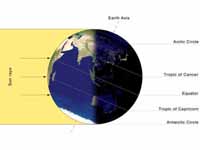Winter Solstice: Few Interesting Remarks
The winter solstice, and thus the official start of the chilly season on the astronomical calendar, begins Monday.

More exactly, the winter solstice begins at 12:47 p.m. EST on Dec. 21.
The Earth is tilted on its axis 23.5 degrees, so it leans one way as it spins around its axis while orbiting the sun. On Dec. 21, the top half of our planet (everything north of the equator) will face directly away from the sun, leaving the North Pole in complete darkness.
Actually, the real feel of winter began long ago. The sun set at the North Pole in late September, and there has been no sunlight nor even twilight since early October. Dawn won't break until early March.
The winter solstice is the day when the sun crosses the sky at its lowest trajectory as seen from the Northern Hemisphere, and so its apparent trek from rising to setting is super quick. Result: the shortest day of the year.
On the bright side, starting Tuesday the days will begin getting longer.
Where we live in the mid-latitudes, daylight ranges from about 15 hours around the summer solstice (when the Northern Hemisphere is tilted toward the sun) to around 9 hours close to the winter solstice.
With less sunlight energy hitting us, temperatures drop. Surprisingly, the Earth is actually closer to the sun during winter in the Northern Hemisphere. It's the tilt that gets us.
And in fact the coldest days of the year are yet to come. Though the days will get longer during January, Northern Hemisphere oceans continue to cool in the relative lack of sunlight, and ocean temperatures drive much of the weather on the continents.
On Monday, the sun will be positioned directly over the Tropic of Capricorn, which is a circle of latitude that marks maps of Earth and passes through South America, the southern tip of Africa and Australia. These spots might be the best bet to catch some rays.
MSNBC.com has contributed to the report.
Subscribe to Pravda.Ru Telegram channel, Facebook, RSS!




